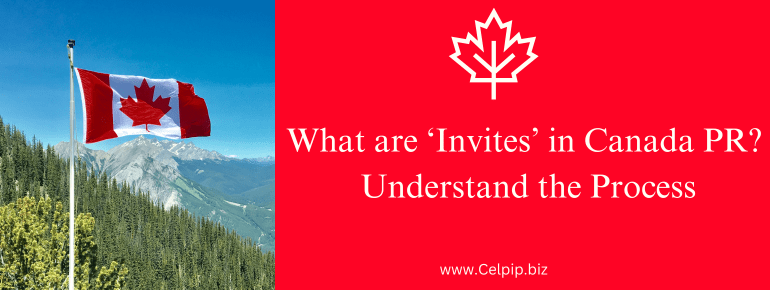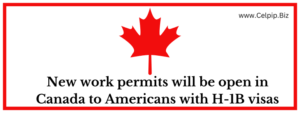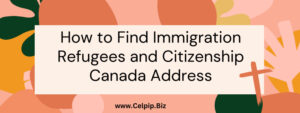Invites in Canada PR: Canada’s immigration system, recognized as one of the most accessible globally, offers multiple pathways for foreign nationals to achieve Permanent Residency (PR) status.
Among these, the Invitation to Apply (ITA) process stands as a cornerstone of Canada’s Express Entry immigration stream.
Through Express Entry, candidates are assessed based on the Comprehensive Ranking System (CRS), which evaluates criteria such as age, education, language proficiency, and work experience.
The Canadian government periodically issues Invitations to Apply to top-ranking candidates in the pool, opening doors for them to begin their journey toward Canadian PR.
Receiving an ITA is the pivotal moment in the Express Entry process, as it grants eligible candidates the opportunity to formally apply for PR.
Given Canada’s high demand for skilled labor across diverse sectors, receiving an invitation can serve as a gateway for individuals seeking not only career opportunities but also a high quality of life and social benefits.
Understanding the ITA process, along with how to maximize one’s chances of receiving one, is essential for potential applicants hoping to build a future in Canada.
Today you will know what a PR invitation entails, the steps involved, and the next steps after receiving one.
Types of Invites in Canada PR
When you seek Canadian Permanent Residency (PR), you may receive an invitation through several established programs that match your qualifications with Canada’s specific immigration needs.
Here’s an in-depth look at the main invite types:
1. Express Entry System Invites
The Express Entry system is one of the most popular pathways for skilled workers to obtain Canadian PR.
Within this system, you submit an online profile with details like your age, education, work experience, and language skills.
Based on these factors, you receive a Comprehensive Ranking System (CRS) score. Express Entry draws take place periodically, with the government selecting top-ranking candidates and issuing Invitations to Apply (ITAs) for PR.
If your profile ranks high among others in the pool, you may receive an invite, and this system is particularly advantageous for those with strong qualifications and experience.
2. Provincial Nominee Program (PNP) Invites
The Provincial Nominee Program is designed for candidates who want to settle in a specific province or territory in Canada.
Each province and territory operates its own PNP and sets unique eligibility requirements based on local economic needs.
After assessing your profile, a province may nominate you if your skills align with its demands.
Once nominated, you’ll receive an additional 600 points toward your CRS score, essentially guaranteeing an invitation in the next Express Entry draw.
You can apply for PNP directly through Express Entry or by reaching out to the provincial governments independently if you meet their specific criteria.
3. Quebec Skilled Worker Program (QSWP) Invites
Quebec has its own immigration system, separate from Canada’s federal programs.
If you’re interested in living and working in Quebec, you would apply through the Quebec Skilled Worker Program (QSWP).
This program evaluates applicants based on factors like language proficiency (especially in French), education, work experience, and ties to Quebec.
When eligible candidates meet the province’s requirements, they receive a Quebec Selection Certificate (CSQ), which allows them to apply for PR at the federal level, bypassing the Express Entry pool.
4. Other Invite Streams
In addition to Express Entry, PNP, and QSWP, Canada offers other PR invite streams tailored to specific groups.
For example, the Atlantic Immigration Program (AIP) is available to skilled workers and graduates looking to settle in Atlantic Canada.
Similarly, the Rural and Northern Immigration Pilot (RNIP) targets skilled workers for rural communities across Canada.
These streams may require an offer of employment from an employer in the target region or recommendations from local community organizations, providing additional avenues for obtaining PR based on regional needs.
Eligibility Criteria for Receiving Invites
To maximize your chances of receiving an invite, it’s essential to understand the eligibility requirements for each program.
These requirements focus on various factors, from your skills and work experience to language ability and adaptability.
1. Factors Considered in Comprehensive Ranking System (CRS)
For Express Entry candidates, the CRS score is crucial.
Your CRS score is based on factors such as age, education level, skilled work experience, language proficiency (in English and/or French), and adaptability.
You can also gain additional points for factors like Canadian work experience, a valid job offer, or a provincial nomination.
Scoring high in CRS is the key to receiving an ITA in Express Entry draws, as candidates with higher scores have a better chance of selection.
2. Provincial Nominee Program Eligibility Requirements
Each province has unique eligibility requirements under the Provincial Nominee Program.
Generally, to qualify for a PNP nomination, you must possess skills and work experience in occupations that are in demand in the province.
Some PNP streams require you to have a job offer from an employer within the province, while others are open to candidates with a strong connection to the province, such as having studied or worked there previously.
Ensuring that your skills match the specific needs of the province where you want to live is essential for nomination success.
3. Quebec Skilled Worker Program Eligibility Criteria
For the Quebec Skilled Worker Program, eligibility is based on different factors compared to the federal system.
You’ll need to demonstrate strong French language skills, which are critical for living in Quebec.
Other criteria include age, educational qualifications, relevant work experience, and ties to Quebec, such as family members residing in the province.
By meeting these criteria, you could receive a Quebec Selection Certificate (CSQ), which is necessary to apply for PR under the QSWP and reside permanently in Quebec.
PR Application Process After Receiving an Invite
Once you receive an Invitation to Apply (ITA) for Canadian Permanent Residency (PR), your journey is only just beginning.
This next stage is crucial, as you’ll need to follow specific steps carefully and ensure all required documentation is submitted accurately and on time.
Here’s a comprehensive look at each phase of the PR application process after receiving an invite.
1. Document Submission
After receiving your ITA, you will have 60 days to submit a completed PR application with all required documents.
Missing or incomplete documents can lead to delays, or even application denial, so gathering and double-checking your documents is essential. Key documents include:
- Proof of Identity and Civil Status – Your passport and, if applicable, marriage or divorce certificates, birth certificates for dependents, and other documentation verifying your civil status.
- Educational Credentials – You must provide Educational Credential Assessments (ECA) for your academic qualifications from designated organizations, which confirm the equivalency of your qualifications to Canadian standards.
- Proof of Work Experience – This includes letters from previous employers detailing your job title, main duties, salary, and duration of employment, as well as pay stubs or tax documents to support your work history.
- Proof of Language Proficiency – You will need to submit the results of your language proficiency test, such as IELTS or CELPIP for English, or TEF/TCF for French. Ensure your test results are within two years of the application date, as they expire after that period.
- Proof of Funds – Unless you have a valid job offer, you will need to provide proof of settlement funds that meet the minimum required amount, which varies based on your family size. Bank statements, investment documents, or fixed deposits are usually accepted forms of proof.
Each document must be clear, complete, and translated into English or French if it’s in another language.
Failure to submit accurate or timely documentation could significantly delay your application or lead to rejection.
2. Medical Examination
The Canadian government requires all PR applicants to undergo a medical examination to ensure they are not a health risk to the country.
You must schedule your exam with a Panel Physician approved by Immigration, Refugees and Citizenship Canada (IRCC). The medical examination includes:
General Physical Exam – The doctor will review your medical history, assess your physical health, and identify any potential issues.
Laboratory Tests – These include blood tests, urine tests, and X-rays, which are used to screen for communicable diseases like tuberculosis and other health conditions that could impact public health in Canada.
Special Assessments if Necessary – For applicants with a history of specific health issues, further testing or specialist evaluations may be required.
After completing the examination, the Panel Physician sends the results directly to IRCC.
The results are valid for 12 months, so it’s advisable to complete the medical exam as close to your application submission date as possible to avoid needing a second test.
3. Background Check
The background check, often referred to as the security clearance, ensures that applicants do not pose a security threat to Canada.
IRCC conducts a thorough assessment of your background, including:
- Criminal History – You may need to provide police certificates from every country where you have lived for six months or longer since age 18. These certificates confirm you have no criminal record and are not considered a risk to Canadian society.
- Immigration History – IRCC will review your history of applications, stays, and any previous refusals or deportations in Canada or other countries.
- Security and Identity Verification – IRCC assesses your application to verify your identity and confirm that all details align with other information provided, aiming to detect any signs of identity fraud.
Completing the background check can vary in time, depending on the applicant’s history, countries of residence, and the complexity of the case.
Being transparent and providing full disclosures where necessary can help expedite this part of the process.
4. Final Decision
Once IRCC completes the document review, medical examination results, and background check, they make a final decision. At this stage:
- Approval of Application – If your application is approved, you will receive a Confirmation of Permanent Residence (COPR) document and instructions on how to complete your PR process, usually requiring you to either visit a port of entry in Canada or meet with an immigration officer for finalization.
- Request for Additional Information – If any issues arise during the review, IRCC may request additional documentation or clarification. Promptly responding to these requests is essential, as delays could impact the timeline of your application.
- Refusal of Application – If your application is refused due to eligibility, inadmissibility, or insufficient documentation, IRCC will provide reasons for the decision. In some cases, you may be able to reapply after addressing the issues, or appeal if you believe the decision was incorrect.
Approval marks the end of the PR application journey and allows you to begin life as a permanent resident in Canada, with access to healthcare, employment rights, and social benefits.
Factors Affecting Invite Frequency and Number
The frequency and number of PR invites in Canada are influenced by several factors, many of which relate to the country’s economic and immigration priorities.
Understanding these factors can help you anticipate the chances of receiving an invitation.
1. Economic Conditions
Canada’s immigration levels are often directly impacted by its economic needs.
During times of economic growth, the demand for skilled workers may increase, leading to a higher number of PR invites.
Conversely, during economic downturns, fewer invitations might be issued as job opportunities decline.
The Canadian government continuously assesses labor market needs and adjusts immigration targets to ensure they meet current and projected economic demands.
For instance, if there’s a high demand in sectors like healthcare, IT, and engineering, the government may increase invites to those with qualifications in these fields.
Economic conditions also influence the CRS cutoff scores in Express Entry draws; during times of higher demand, scores may decrease, allowing more applicants to qualify.
2. Immigration Targets
Canada’s immigration targets are set by the federal government in multi-year immigration plans that outline how many newcomers Canada hopes to welcome across various categories.
These targets are aligned with Canada’s long-term economic and demographic goals, such as addressing labor shortages, supporting an aging population, and fostering regional development.
For instance, in recent years, Canada has increased its immigration targets to combat the effects of an aging population and lower birth rates, ensuring a steady flow of skilled workers to maintain economic growth.
Immigration targets influence how often IRCC conducts Express Entry draws, how many invitations are issued, and the number of nominations each province receives for its PNP.
3. Demand for Skilled Workers
Canada uses its immigration system to meet specific labor shortages in key industries, especially in sectors with high demand for skilled workers, such as healthcare, technology, and trades.
When there is a notable shortage in a particular skill or occupation, more invitations are likely issued to candidates who meet these qualifications.
Programs such as the Federal Skilled Worker Program (FSWP), Federal Skilled Trades Program (FSTP), and Canadian Experience Class (CEC) prioritize applicants based on Canada’s needs in skilled labor.
Moreover, PNPs often update their eligibility criteria to reflect the occupations in demand within specific provinces, encouraging more candidates with the right skills to apply.
Conclusion
Canada’s PR invitation process embodies the country’s commitment to building a skilled and diverse workforce, aligning immigration needs with national economic goals.
The ITA is more than just a formal invitation; it is a significant step toward achieving one’s dreams of residing permanently in Canada.
By understanding the PR invitation process, candidates can take informed steps, such as improving their CRS scores and carefully preparing their documentation, to improve their chances of selection.
For those who are granted an ITA, the path forward involves diligent completion of required procedures and documentation, ultimately leading to PR status and the opportunity to live, work, and thrive in Canada.
As such, receiving an invitation for Canadian PR is both an achievement and a starting point for many immigrants who aspire to make Canada their home.
A strong understanding of the process can ensure a smooth transition from candidate to permanent resident, making it an important milestone on the journey to becoming part of Canada’s vibrant and inclusive society.
Frequently Asked Questions (FAQs)
- What is PR invitation in Canada?
A PR invitation, or Invitation to Apply (ITA), is a formal invitation issued by the Canadian government to eligible candidates in the Express Entry pool, allowing them to submit a PR application.
- How to get invited for PR in Canada?
To receive a PR invitation, candidates must first create an Express Entry profile and secure a high CRS score, typically through qualifications in education, language, and work experience.
- How long does it take to get an invitation for PR?
The wait for an invitation varies based on the candidate’s CRS score, with higher-scoring applicants typically invited within the next Express Entry draw, which occurs approximately every two weeks.
- How do you get invited for PR?
Candidates receive an invitation for PR by ranking among the top scores in the Express Entry pool, following regular draws conducted by the Canadian government.
- What does PR invite mean?
A PR invite signifies the Canadian government’s interest in a candidate’s profile, permitting them to submit a comprehensive PR application for review.
- What happens after an invitation to apply to Canada?
After receiving an invitation, the candidate has 60 days to submit their PR application, including all required documents and fees, to be processed for final PR approval.




